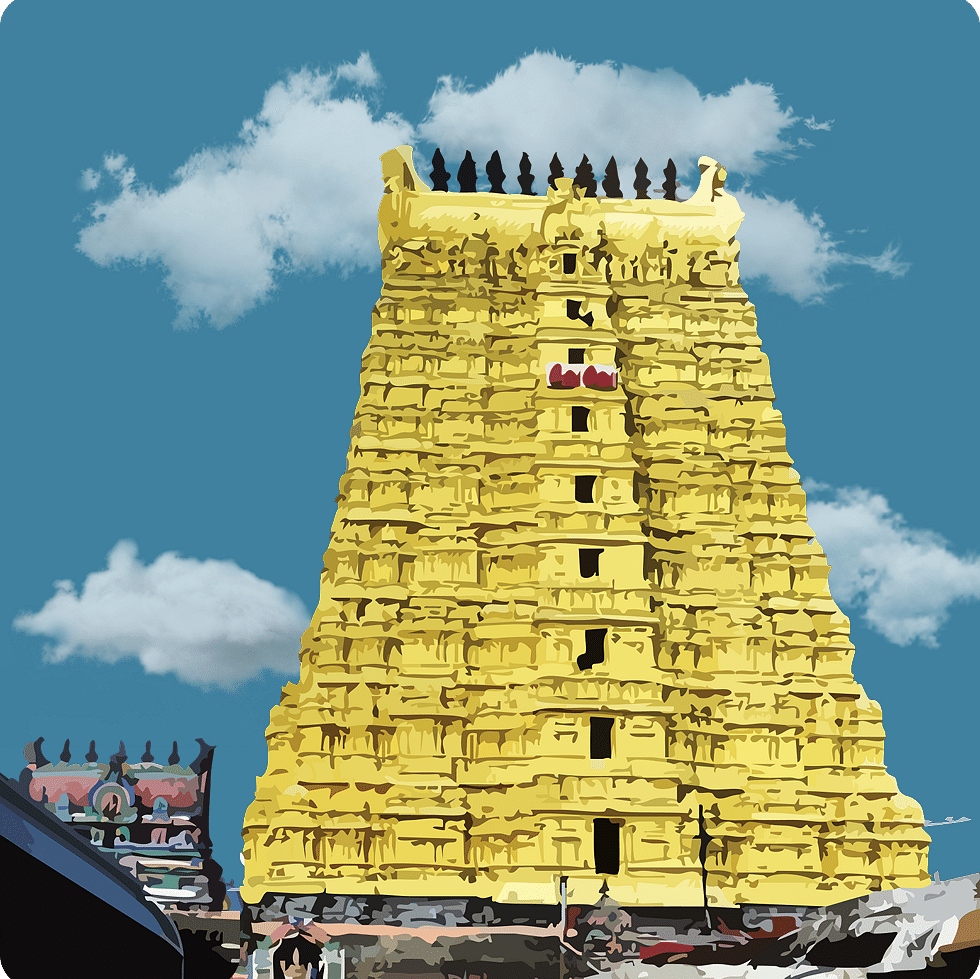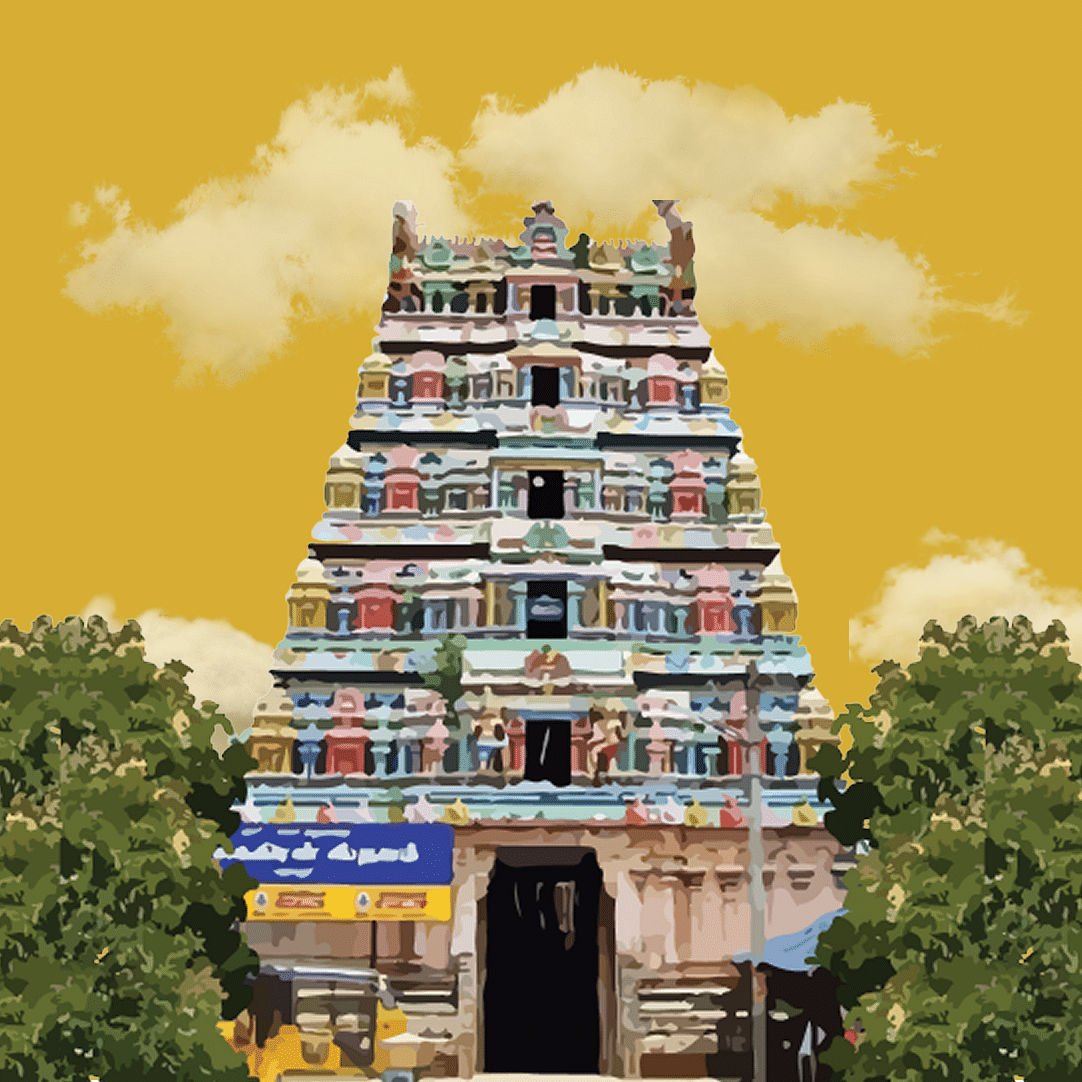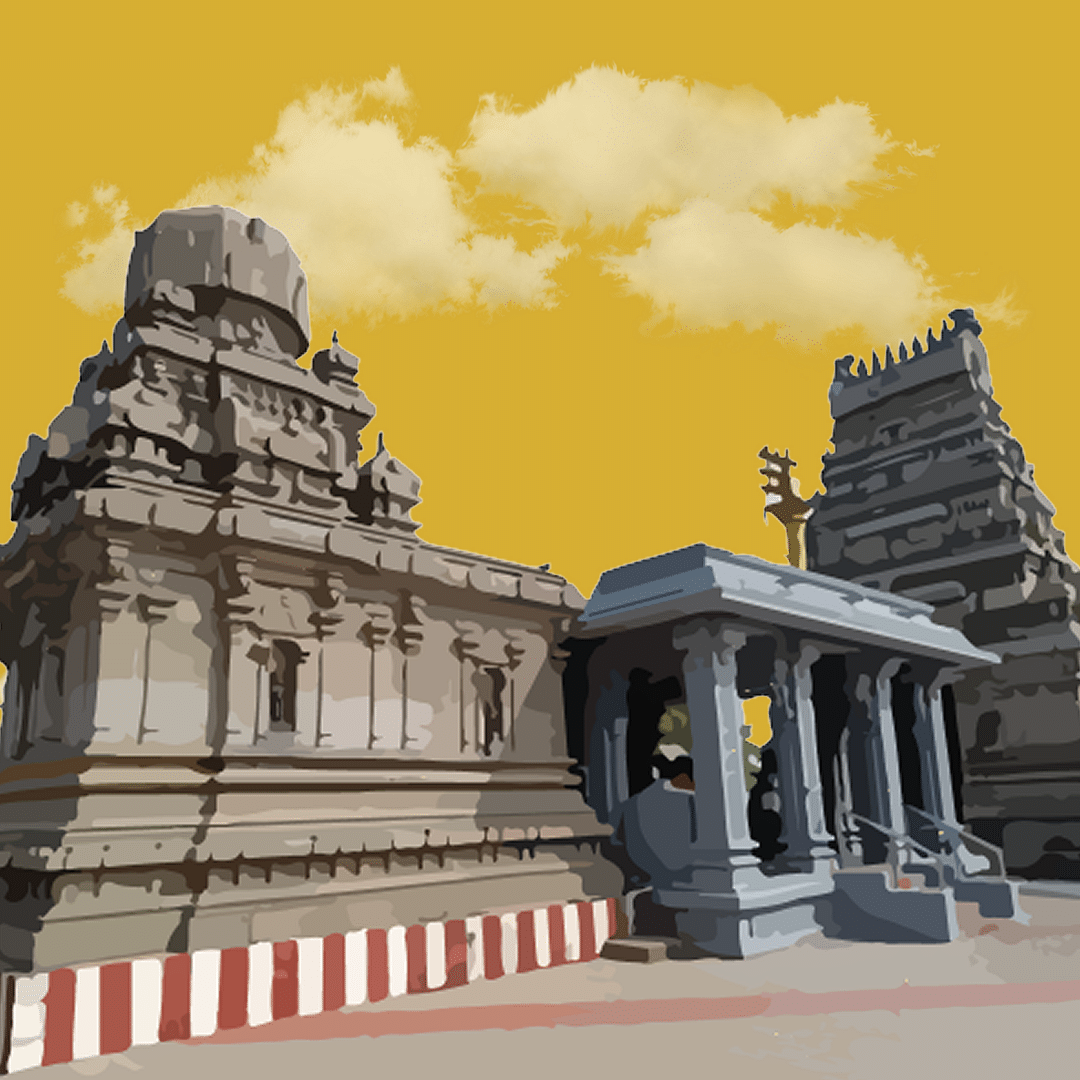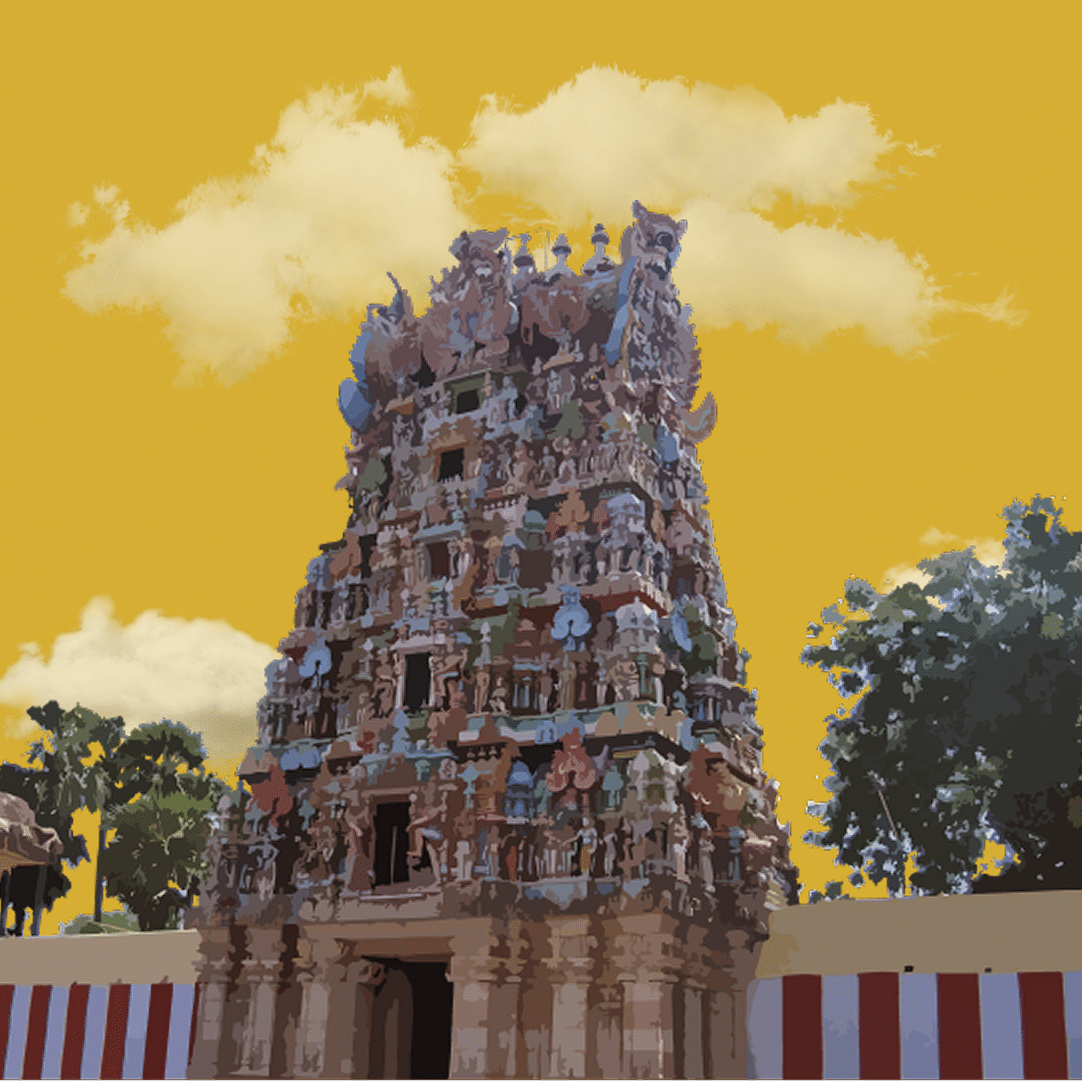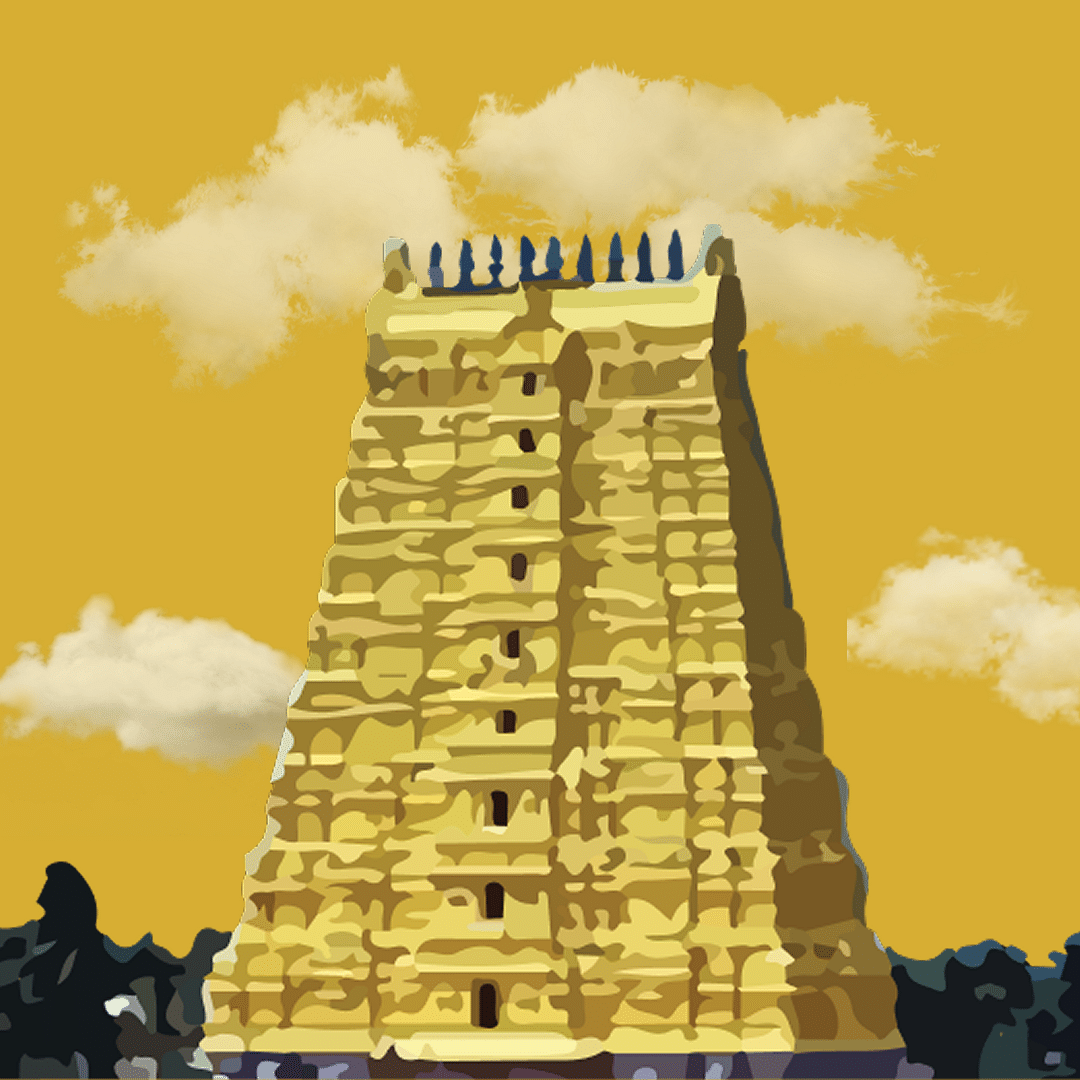Home > The GReaT Divine Darshan > Madurai
HOLY PLACES
IN MADURAI
Madurai, the cool elder cousin of Tamil Nadu, is filled with stories older than your grandma’s spice box. At its heart is the legendary Meenakshi Amman Temple, where the gopurams are so colourful, even peacocks feel envious. The temple’s deity, Goddess Meenakshi, is regal, fierce, and deeply revered—she’s the symbol of grace and strength, and the reason people from around the world visit the city. When it comes to temples in Madurai, each one has its own soul and story, adding layers to the city’s sacred rhythm. Even the streets here come alive with rhythm—autos swerving like it’s a sport, and food carts dishing out miracles on banana leaves. Ever tried Jigarthanda? It’s like a cold hug from the gods. And those Madurai dosas? They flip faster than your weekend plans. By evening, the city turns mellow. Temple bells play backup to your thoughts, jasmine sneaks into the breeze, and somewhere between the snacks and the sanctity, Madurai charms its way into your heart, without even trying.
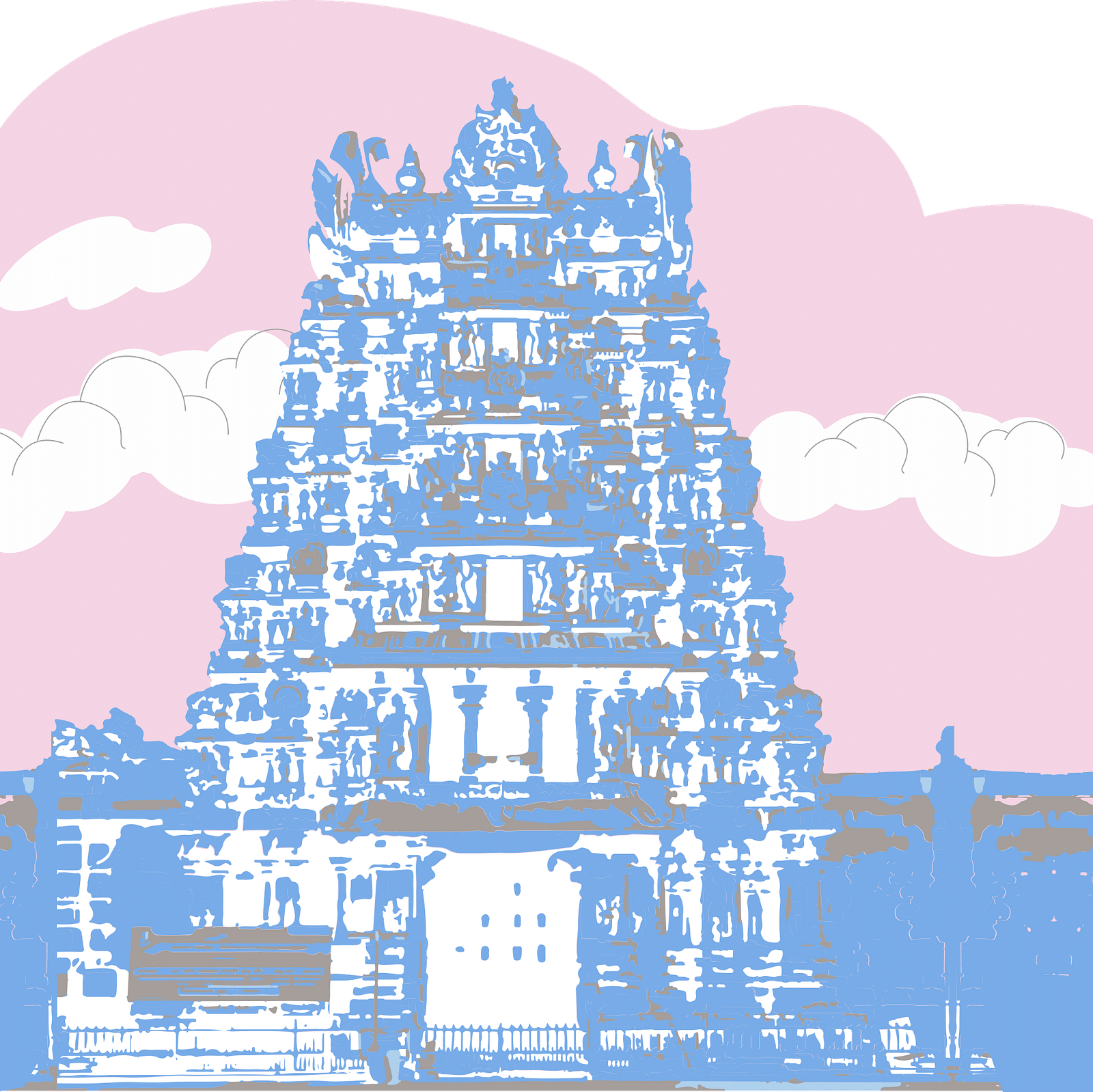
 OUR Hotels
OUR Hotels
IN THE CITY, BY THE SACRED SITES 🏙

Regency Madurai By Grt Hotels
Plotting your pilgrimage to Madurai? Regency Madurai by GRT Hotels is your perfect launch pad—just a short ride away from the iconic Meenakshi Amman Temple. While she handles the divine grace, we’ve got the divine comfort sorted with 57 plush rooms, a sparkling pool, and service that feels like a warm filter coffee hug. Here for business? Our event spaces are all set to host everything from corporate chinwags to cousins’ weddings. Hungry? Ahaaram turns up the heat with fiery local favourites that’ll have your tastebuds doing a dance of their own. So whether it’s darshan, deals, or just downtime, you’re after—Madurai’s magic begins right here.

Grand Madurai by GRT Hotels
Madurai, known as Thoonga Nagaram (translating as ‘the city that never naps’), is an amalgamation of lively chaos. From the dazzling Meenakshi Amman Temple to the shoppers' favourite Naalangadi and Allangadi markets, there’s always something buzzing here. And smack dab in the middle of all the buzz is Grand Madurai by GRT Hotels. We’re talking cloud-like beds, air-conditioning that knows when you’ve had enough of the heat, and a spa that pampers you better than your grandma on Pongal day. After all, who says you can’t be divine and decadent at the same time? Whether you’re temple-hopping, saree-shopping, or just plotting your next filter coffee break, we’re your comfy command centre. So go on—bring your curiosity, your camera, and your stretchy pants. Madurai’s waiting. And we’ve got the pillows.
 OURDivine Destinations
OURDivine Destinations
TRAVEL THROUGH THE MUSEUMS OF FAITH 🛕
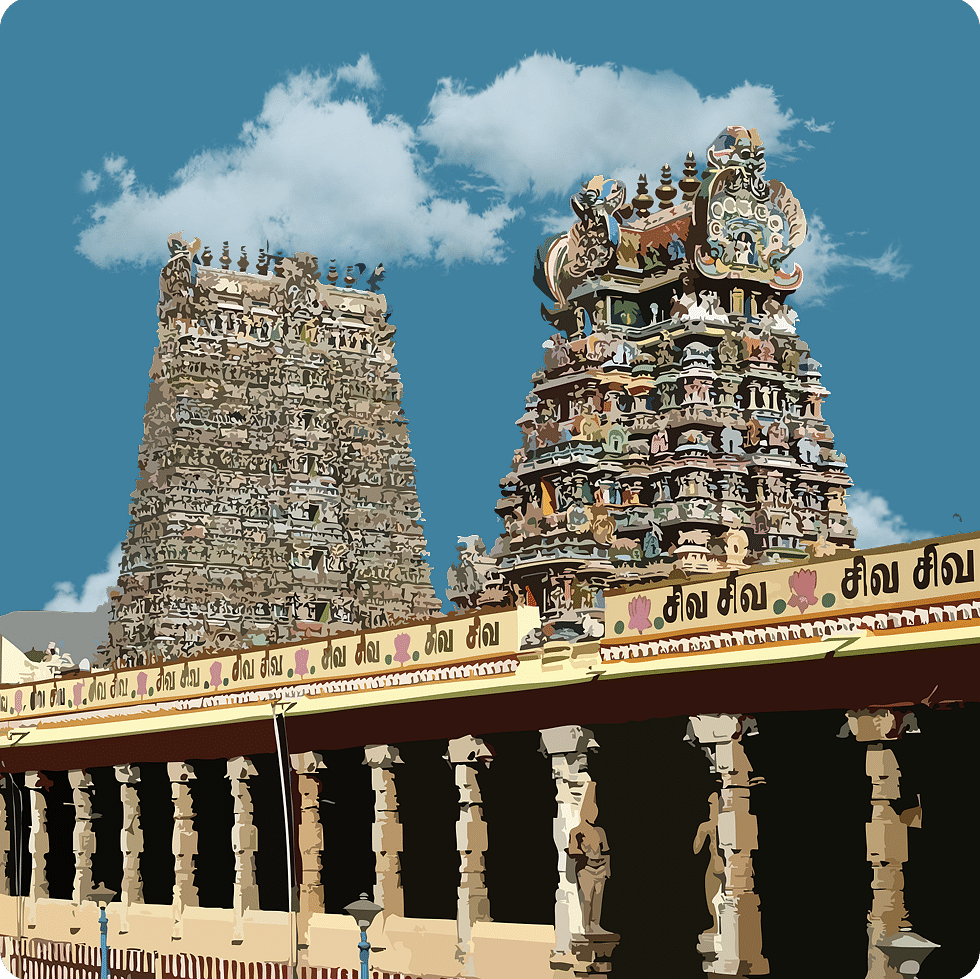
ARULMIGU MEENAKSHI AMMAN
TEMPLE ✨
A legend of divine grace, where Meenakshi, born with three breasts, was transformed under Shiva’s guidance. Their celestial wedding, believed to have taken place here, marked the beginning of a divine legacy, attended by gods and goddesses.
Distance from Regency Madurai4 km
Distance from Grand Madurai9 km
Timing5.00 a.m. to 12.30 p.m.
4:00 p.m. to 9:30 p.m.FestivalMeenakshi Thirukalyanam: (Apr-May)
Theppa Thiruvizha: (Jan-Feb)
Thiruvathirai-Arudra Darsan: (Dec-Jan)
Masi- Mandala Utsavam: (Feb-Mar)
Navaratri: (Sep-Oct)
Alagar's river plunge: (Apr-May)Sacred Food OfferedPuliyodharai (Tamarind rice), Chakkarai pongal (Sweet pongal), Laddu, Appam
Transportation CostFor assistance, please contact the front desk.
Disclaimer: The temple's timings are subject to change as per the operating committee's decisions.
About Arulmigu Meenakshi Amman Temple:
- The temple is located on the southern bank of the Vaigai River and is dedicated to Meenakshi Amman, a form of Parvati, and her consort, Sundareshwarar, a form of Shiva.
- The temple is mentioned in 6th-century AD Tamil Sangam literature, highlighting its ancient significance.
- It is one of the 275 Paadal Petra Sthalams, temples that are revered in the verses of Tamil Saiva Nayanars from the 6th to 9th century AD.
- It is believed that Lord Shiva, in the form of Sundareswarar, married Meenakshi, the daughter of the Pandya ruler, at the site of the temple.
- The temple was originally said to date as far back as the 4th century AD, but was constructed in its present form during the 16th–17th centuries.
- The temple was nominated as one of the wonders of the world, although it did not make it to the final list. However, it is still considered one of the ‘Wonders of India’.
- The temple attracts 1,000’s of devotees every day, with the annual Tirukalyanam Festival drawing over a million visitors.
- The temple complex is enclosed by high walls, with soaring gateway towers known as gopuras, which are some of the most elaborately decorated in India.
- There are 14 gopuras in total, with the southern gopura being the tallest, rising to over 170 ft. (52 m).
- Inside the temple, there are colonnades, columned mandapas (halls), a sacred tank, smaller shrines, and the two main parallel shrines dedicated to Sundareswarar and Meenakshi.
- The temple's Aiyaram Kal Mandapa (translated as the thousand-pillar hall) contains 985 intricately carved columns depicting divinities, female musicians, and other attendants.
- The Meenakshi shrine stands in its enclosed area, which includes subsidiary shrines and a bedchamber where Sundareswarar's image is brought every night from his own shrine.
- The temple is a living institution, with weekly rituals where the golden idols of Meenakshi and Sundareswarar are placed on a swing and hymns are sung.
- The temple tank, known as Pottamarai Kulam (Golden Lotus Pond), holds a golden lotus at its centre. It is believed that those who sprinkle its sacred waters on Amavasya, the first day of the month, eclipses, and other auspicious days, followed by worship, will be blessed with the fulfilment of their aspirations.
- During the Theppa Thiruvizha, Goddess Meenakshi and Lord Sundareswarar are first stationed at the banks of the Mariamman Teppakulam, offering blessings until dusk, before being placed on floats and ceremoniously pulled across the sacred tank.
Divine Facts:
Once upon a time, in a land where royal wishes often got tangled up in divine unpredictability, King Malayadwaja Pandya and his queen, Kanchanamalai, performed a grand Yajna with one simple wish: to have a son who would inherit the throne. But when the gods are involved, plans tend to take a creative turn. Instead of a son, the couple was blessed with a daughter. And not just any daughter—this little one was already three years old, and she had three breasts. It's safe to say the royal couple were less than prepared for this. Enter Lord Shiva, who advised the king and queen to raise their daughter like a son. And as for the third breast? Shiva promised that it would vanish when she met her husband. The royal couple took the advice in stride, because when the Lord gives you advice, you don’t exactly say no. As time passed, the little girl grew into a powerful, confident woman, inherited the throne, and lo and behold, when she finally met her divine husband, Shiva’s words came true. With a sudden and graceful transformation, she shed her third breast and revealed her true form—Meenakshi, the goddess of unmatched beauty, grace, and wisdom. But the real spectacle came when Meenakshi and Lord Shiva got married. It wasn’t just a wedding—it was the celestial event of the century. The heavens were buzzing, gods and goddesses from every realm made an appearance, and the whole universe turned up to celebrate. When two such powerful deities like Meenakshi and Shiva unite, it’s not just a wedding—it’s a cosmic fiesta, complete with divine revelry, celestial music, and a little bit of cosmic drama for good measure. It is believed that Lord Shiva, in the form of Sundareswarar, married Meenakshi, the daughter of the Pandya ruler, at the site of the temple.THIRUPARANKUNDRAM MURUGAN
TEMPLE✨
A sacred site of divine unions, where Lord Murugan married Devasena, daughter of Indra. Carved from rock, this temple houses Murugan, Shiva, and Vishnu in rare harmony, surrounded by celestial alignments and ancient theerthams.
Distance from Regency Madurai5 km
Distance from Grand Madurai11 km
Timing5:00 a.m. to 12:30 p.m.
4:00 p.m. to 9:30 p.m.FestivalSkanda Sashti: (Oct-Nov)
Panguni Uthiram: (Mar)
Thai Poosam: (Jan-Feb)
Brahmotsavam: (Mar-Apr)
Chittirai festival: (Apr-May)
Karthigai Deepam: (Nov-Dec)
Vaikasi Visakam: (Jun)Sacred Food OfferedPanchamirtham, Puliyodharai, Sundal
Transportation CostFor assistance, please contact the front desk.
Disclaimer: The temple's timings are subject to change as per the operating committee's decisions.
About Thiruparankundram Murugan Temple:
- The temple is one of the six main shrines of Lord Murugan, making it a pivotal site for devotees seeking blessings from the god of war and wisdom.
- Carved out of rock, the temple dates back to the 6th century and was built during the reign of the Pandya dynasty. The rock-cut architecture adds a unique charm to its structure.
- It is believed to be the site where Lord Murugan married Goddess Devasena, the daughter of Lord Indra, which is why it is considered especially auspicious for couples seeking blessings for a happy marriage.
- The temple is a blend of architectural styles from both the Pandya and Nayak periods, with exquisite carvings and mandapams that reflect the craftsmanship of the time.
- A standout feature of the temple is the unique positioning of the idols of Lord Shiva and Lord Vishnu, which face each other—a rare and significant aspect in Hindu temples.
- The temple's innermost sanctum houses idols of Lord Shiva, Lord Vishnu, Lord Vinayaka, Goddess Durga, and Lord Murugan, all intricately carved into the rock, creating a spectacular sight for visitors.
- A popular legend associated with the temple is the belief that couples who marry here receive Lord Murugan's blessings for a blissful life together.
- In addition to its Hindu significance, the temple also houses a Muslim shrine dedicated to Sekunder, who, according to some legends, was a close companion of Lord Murugan.
- The temple is renowned for its artistic mandapams, particularly the Aasthaana Mandapam, which is admired for its carved pillars and intricate design.
- Visitors can also marvel at the carvings of Lord Shiva in various dance forms, as well as depictions of Mahishasura Mardini and other divine figures.
Divine Facts:
When the demon Tarakasura threw the universe into turmoil, not even the stars could twinkle in peace. His power was off the charts, his ego even higher—and the gods, out of their league. The catch? He could only be defeated by a son of Shiva. But Lord Shiva, deep in penance and cosmic silence, wasn’t exactly in a matchmaking mood. So the gods did what desperate celestial beings do—they prayed, pleaded, and eventually got Shiva and Parvati to unite in divine purpose. From this fiery union was born a force too powerful to be cradled in mortal arms—six sparks of divine energy, glowing with pure potential. The flames were too intense for the earthly realm, so Agni (god of fire) and Vayu (god of wind) stepped in like divine delivery agents, carrying the sparks to a place that could handle such heat. Enter Saravana Poigai—a serene, lotus-studded lake hidden among whispering reeds and swaying trees. It wasn’t just a body of water; it was a cosmic cradle. In its calm waters, the sparks transformed into six radiant infants, each glowing like a miniature sun. Now came the nannies of the stars—the Krittikas, six celestial nymphs, who found the divine children blooming like lotuses in the lake. With love that rivaled the stars, they each took in a child, raising him with the care of a mother and the wisdom of the heavens. These six infants, full of divine energy and mischief, grew up under their watchful eyes. When Goddess Parvati saw them, her heart overflowed. In a moment that redefined divine motherhood, she embraced them all—and they merged into one mighty form with six faces and twelve arms, known as Shanmukha, or Murugan, the god of war, wisdom, and victorious eyebrows. But Saravana Poigai wasn’t done. It became Murugan’s training ground—his classroom, his playground, and his armory. Here, the young god was equipped with celestial weapons, divine knowledge, and a mission—to defeat the demon who had shaken the balance of the cosmos. The lake, now etched into legend, wasn’t just water and reeds anymore. It had become a symbol of nurture, divine potential, and spiritual energy. Even today, the air around Saravana Poigai hums with a kind of sacred nostalgia, as if the wind still carries whispers of the Krittikas and the laughter of the six divine infants. And so, Saravana Poigai lives on—not just in geography, but in mythology.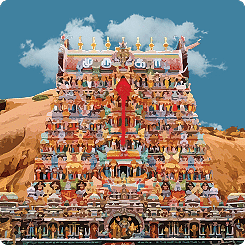

ARULMIGU SOLAIMALAI MURUGAN TEMPLE, PAZHAMUDIRCHOLAI✨
When a tired Avvaiyar paused beneath a tree, Murugan, ever playful, offered her fruit with a twist. His riddle of cooked or uncooked sparked not just laughter, but sudden enlightenment, revealing the divine behind the disguise.
Distance from Regency Madurai32 km
Distance from Grand Madurai28 km
Timing5:30 a.m. to 1:00 p.m.
4:00 p.m. to 9:00 p.m.FestivalSkanda Sashti: (Oct-Nov)
Panguni Uthiram: (Mar)
Thai Poosam: (Jan-Feb)
Brahmotsavam: (Mar-Apr)
Chittirai festival: (Apr-May)
Karthigai Deepam: (Nov-Dec)
Vaikasi Visakam: (Jun)Sacred Food OfferedPazham (Fruits), Panchamirtham, Sweet pongal
Transportation CostFor assistance, please contact the front desk.
Disclaimer: The temple's timings are subject to change as per the operating committee's decisions.
About Arulmigu Solaimalai Murugan Temple:
- This sacred site is enveloped by thick forests, offering a tranquil and scenic setting for worship.
- It is one of the six revered abodes of Lord Murugan in Tamil Nadu, collectively known as the Arupadaiveedu, and holds a special place in Tamil devotional tradition.
- The temple finds mention in classical Tamil literature such as the Ettutokai, Pattupattu, and Silappathikaram, reflecting its ancient significance and cultural heritage.
- The deity here is worshipped along with his two consorts—his wives, Goddesses Valli and Deivayanai—symbolising divine harmony and companionship.
- Pilgrims often visit to seek blessings for marriage, children, and academic pursuits, with many considering it a place of answered prayers.
- Apart from its religious importance, the serene environment and natural beauty of the surrounding forest make it a peaceful retreat for visitors.
Divine Facts:
Tamil Nadu was and always has been the epicentre of wisdom, wit, and poetic debates. Back in one of those days, when gods were imparting wisdom to their beloved devotees, lived a legendary poetess, Avvaiyar. Known for her quick wit and even quicker rhymes, she wandered through the forests, spreading her wisdom far and wide. One fine day, as destiny would have it, she found herself taking a much-needed break under a tree, with nothing but the whisper of the wind and the rustling leaves for company. By then, Avvaiyar had grown proud, believing she had mastered the path of wisdom and that there was nothing left to learn. Lord Murugan, ever the playful teacher, decided it was time for a little divine intervention. Disguised as a young shepherd boy, sitting high on a Naaval tree, he was waiting to teach her a friendly lesson. Even the gods sometimes like a bit of mischief, and this particular day, Murugan decided to add some fun to the situation. From his perch above, he noticed Avvaiyar below and thought it the perfect opportunity to offer her some fruit. After all, nothing says ‘divine wisdom’ quite like a spontaneous fruit delivery. The boy asked if she wanted ‘cooked’ or ‘uncooked’ fruit. Avvaiyar, ever the scholar but not exactly a culinary expert, had no idea what that meant. So, she went with the ‘cooked’ option. Moments later, the fruits tumbled down, landing with a satisfying thud right on the dusty ground. Now, being the practical, no-nonsense poetess she was, Avvaiyar bent down to clean the fruits, trying to blow the dust away. At that very moment, the boy, with a mischievous grin, asked if the fruits were ‘hot’ (Sutta Pazham). And there it was: the lightbulb moment. Avvaiyar instantly realised the divine lesson hidden in the playful exchange, her eyes lighting up as she grasped Murugan’s cheeky way of teaching her a lesson in wisdom. The temple and the legendary rose apple (Naaval) trees tied to this cheeky divine episode are still around, standing tall like silent storytellers. These trees usually bear fruit from July to September, but the one inside the temple? It’s got a flair for drama! It waits for Skanda Sashti, six days after Deepavali, to show off its ripened fruits—like it’s keeping the tradition alive and saying, ‘This is when the real lesson drops!’ Even the tree seems to know that Murugan’s mischief deserves an annual encore.ARULMIGU KALLAZHAGAR SUNDARAJA PERUMAL TEMPLE✨
When a divine wedding invite went unanswered in time, Vishnu didn’t sulk—he simply made the hills his new home. And so, in the heart of these sacred woods, he remains as the ever-gracious Alagar, blessing devotees with timeless charm.
Distance from Regency Madurai29 km
Distance from Grand Madurai25 km
Timing6:00 a.m. to 12:30 p.m.
3:30 p.m. to 8:30 p.m.FestivalChithirai Festival: (Apr-May)
Navarathri; (Sep-Oct)
Vaikunta Ekadesi: (Dec)
Float Festival: (Jul-Aug)Sacred Food OfferedMelagu dosai
Transportation CostFor assistance, please contact the front desk.
Disclaimer: The temple's timings are subject to change as per the operating committee's decisions.
AboutArulmigu Kallazhagar Sundaraja Perumal Temple:
- The temple is situated amidst the lush foothills of the Alagar Hills, offering visitors not just spiritual solace but also a visually serene atmosphere.
- It is believed that the main deity, revered here as the brother of Goddess Meenakshi, once set out to attend her celestial wedding but turned back upon discovering he had arrived late.
- The temple features a stunning five-tiered gopuram and is enclosed within robust granite walls, reflecting classic South Indian temple architecture. Apart from religious value, the temple is known for its scenic hilltop location, offering beautiful views of the surrounding landscape.
- Inside the sanctum, the deity is flanked by Sridevi and Bhudevi, with intricate carvings adorning the surrounding structures.
- Two majestic statues of Lord Narasimha can be found within the premises—one capturing the moment of holding the demon Hiranyakashipu, and the other depicting his divine slaying.
- The surrounding hill has historic links to Jainism, with caves bearing Brahmi inscriptions believed to date back to the 1st century B.C.
- The temple has received poetic praise in over 120 hymns by celebrated Alvars like Nammalvar, Andal, and Thirumangai Alvar.
- Noteworthy contributions to the temple's construction and embellishment were made during the Pandyan and Nayaka reigns, with golden plating and elaborate mandapams added over time.
- The Kalyana Mandapam stands out for its detailed Nayaka-era sculptures, including depictions of mythological scenes and divine figures.
- Nearby sacred water sources, such as Noopura Ganga and Garuda Theertham, are considered to possess purifying powers and attract devotees year-round.
Divine Facts:
Several moons ago, when celestial calendars weren’t synced with earthly invites, a rather royal guest set out for a wedding—Lord Vishnu himself. The occasion? The grand union of Lord Sundareswarar and Goddess Meenakshi, a match made in divine heaven. Now, here’s the cosmic twist—Lord Vishnu wasn't just a guest; he was the bride's brother. Yes, the Chithirai Thiruvizha, Madurai’s most iconic festival, celebrates not only the divine wedding but also the celestial role Lord Vishnu plays in giving away Meenakshi in marriage—a traditional brother’s duty. Dressed in all his glory and probably carrying a cosmic wedding gift, Vishnu made his way from his abode in Thirupparkadal to Madurai, ready to shower blessings, perform his brotherly duties, and maybe snag some laddus. But by the time he reached the banks of the Vaigai River, the celebrations had wrapped up. Vows had been exchanged, garlands tossed, and the divine couple was well into their happily ever after. With the ceremony already done and dusted, Vishnu did what any dignified guest would—he gracefully turned back, no drama, no divine sulk. He didn’t return empty-handed, though. Enchanted by the serenity of the surrounding hills, he chose to settle down right there. And that’s where he continues to reside as Lord Kallazhagar—watching over the land with the calm of someone who knows he’s always fashionably divine, even if slightly late.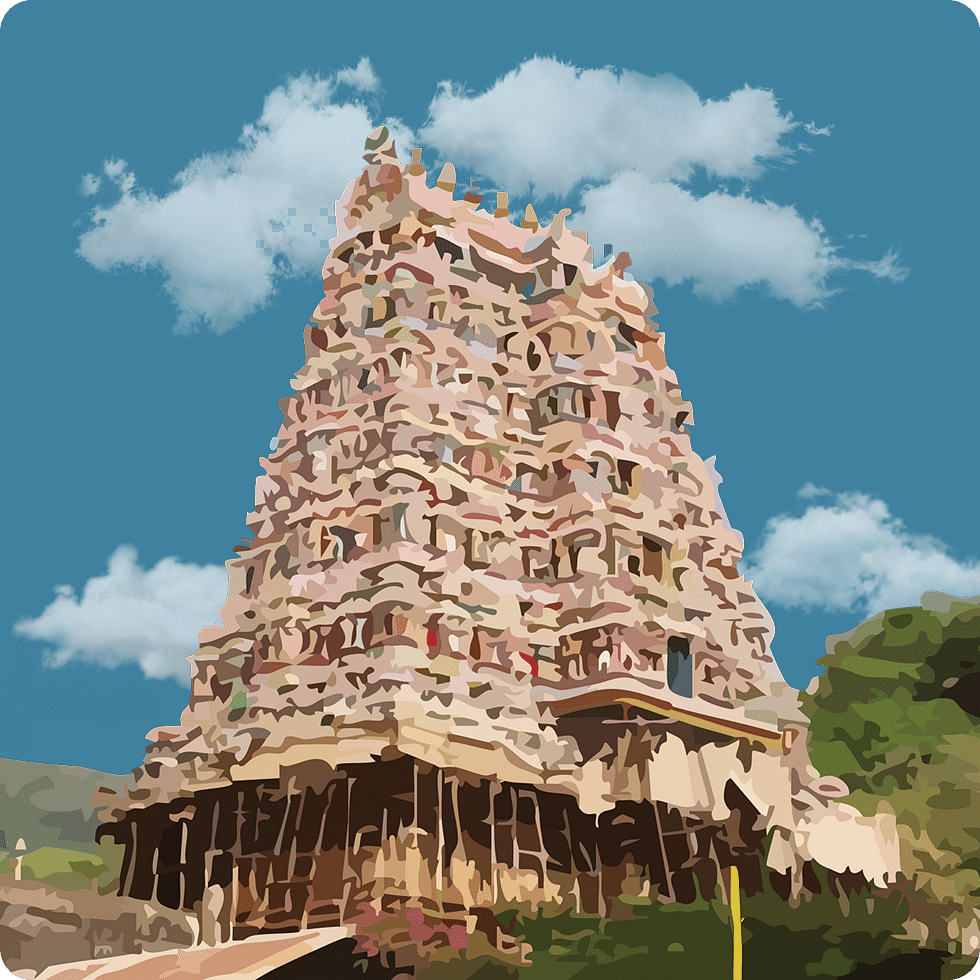
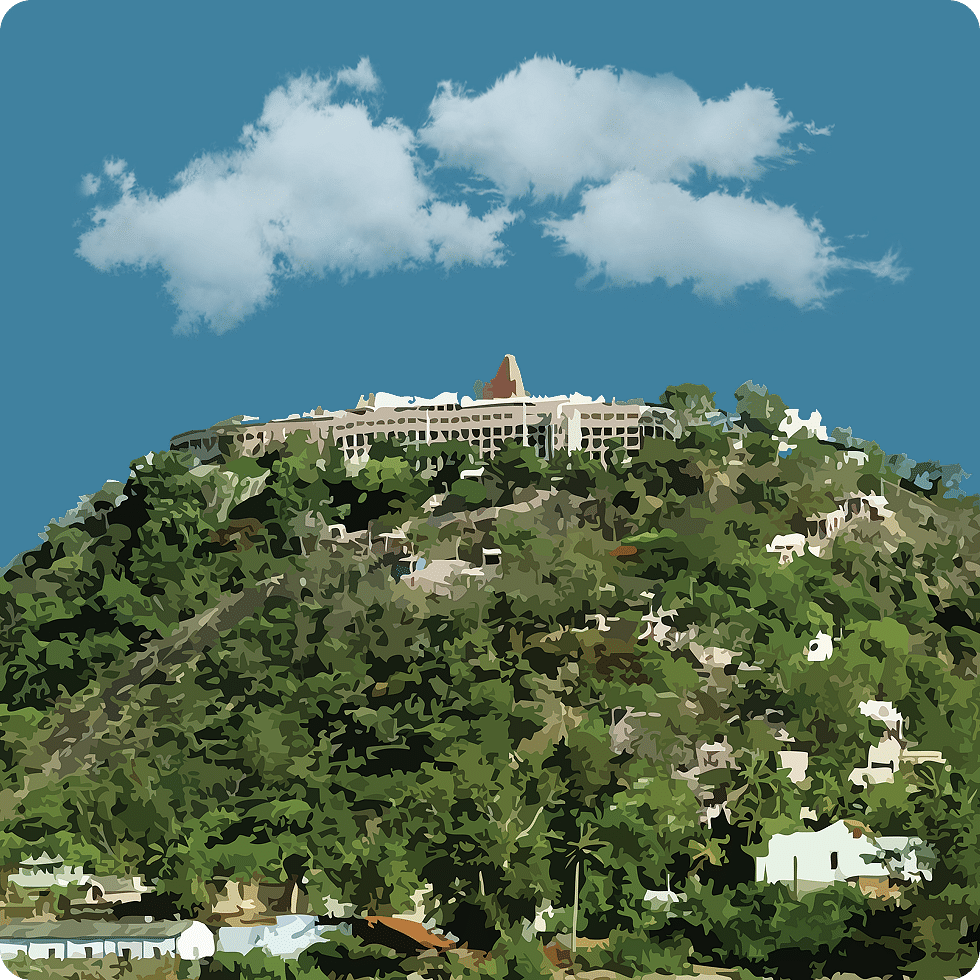
ARULMIGU DHANDAYUTHAPANI SWAMY TEMPLE✨
Murugan, overlooked in the divine fruit contest, retreated to Palani’s Sivagiri hill. Sage Bhogar’s navapashanam idol draws pilgrims carrying kavadis. Rituals like sandalwood anointing and vibrant Thai-Poosam celebrations make this temple a beacon of devotion and tradition.
Distance from Regency Madurai116 km
Distance from Grand Madurai138 km
Timing6:00 a.m. to 12:30 p.m.
4:00 p.m. to 8:00 p.m.FestivalAadi Kirthigai: (Jul)
Aani Annabhishekam: (Aug-Sep)
Vaikasi Visakam: (Jun-Jul)
Panguni Uthram: (Mar-Apr)
Thaipusam Festival: (Jan)
Kandha Sashti: (Oct-Nov)
Margazhi Poojai: (Dec)
Thiru Karthigai: (Nov-Dec)Sacred Food OfferedPanchamirtham (Banana-based divine mix), Laddu
Transportation CostFor assistance, please contact the front desk.
Disclaimer: The temple's timings are subject to change as per the operating committee's decisions.
About Arulmigu Dhandayuthapani Swamy Temple:
- It is revered as one of the Six Abodes of Murugan, central to the devotion of Lord Karthikeya in Tamil Nadu.
- The temple is located atop the Sivagiri hill in Palani, within the Dindigul district.
- It is deeply rooted in mythology, with legends connecting it to the divine episode of the gyana-palam, or the fruit of wisdom.
- As per tradition, Murugan chose Palani as his abode after relinquishing his claim to the fruit of knowledge, feeling slighted by Shiva’s decision.
- The temple’s primary idol is made from navapashanam, a mystical amalgamation of nine poisonous substances believed to form an eternal medicinal compound.
- Sage Bhogar, one of the legendary siddhars of ancient Tamil tradition, is credited with crafting the idol and establishing the shrine.
- An underground passage is believed to link the temple to a secret cave where Bhogar continues his spiritual meditation.
- The sanctum sanctorum houses the deity in the form of a youthful ascetic, symbolically stripped of royal ornaments and carrying only a staff.
- The temple fell into neglect over time and was later rediscovered and restored by a Chera king, following a divine vision.
- It is traditional for devotees to shave their heads as an act of humility and devotion before offering prayers.
- A distinctive religious practice includes the nightly anointing of the deity’s head with sandalwood paste, known as rakkala chandaṇam, which is believed to gain medicinal properties overnight.
- Devotees often carry kavadi or pots of holy water over long distances as a form of penance and worship.
- The temple celebrates major festivals like Thai-Poosam, Pankuni-Uththiram, Vaikashi-Vishakham, and Soora-Samharam with great fervour, attracting pilgrims from across South India.
- Thai-Poosam is considered the grandest festival, marked by strict vows of abstinence, barefoot pilgrimages, and the carrying of elaborately decorated kavadis.
- Special recognition is given to pilgrims from Karaikudi during Thai-Poosam, who bring the Lord’s diamond-studded vel (spear) to the temple.
- The sacred Panchamirdham, a blend of five natural ingredients, continues to be a cherished offering, believed to have divine origins.
- Modern access to the temple is facilitated by a winch, a rope car, and traditional stairways, allowing pilgrims of all ages to make the ascent.
- Historically known as Thiruaavinankudi, it finds mention in the ancient Sangam work Tirumurukarruppaṭai.
- The temple remains a living symbol of devotion, legend, and Tamil spiritual heritage, nestled serenely amidst the Palani Hills.
Divine Facts:
Before time ticked its first second and the stars were just twinkles waiting to be born, the universe was a vast, silent canvas. And in the very heart of this cosmic blank space, on the sacred Mount Kailash, the gods gathered to kick-start the whole creation thing. As the divine hustle began, Sage Narada—always on the lookout for a little drama—suddenly appeared, adding a bit of flair to the celestial proceedings. With a flourish, he presented Lord Shiva with the gyana-palam, a mystical fruit brimming with wisdom that promised to outshine even the stars. Shiva, with his usual air of calm, decided to make this moment a family affair. He declared that the fruit would go to whichever of his sons, Ganesha or Murugan, could circle the world three times. Murugan, ever the athletic one, leapt onto his mighty peacock and took off with the enthusiasm of someone who’s just been told they can’t finish their breakfast until they’ve completed a lap around the planet. His journey was swift, his peacock proud, and his competitive spirit. Meanwhile, Ganesha, who had never been one to rush about (why bother when you can think your way through it?), saw the world in a different light. Instead of circling the globe, he looked at his parents, the very foundation of the universe, and realised: ‘Why travel when the world is in front of me already?’ So, with a deep, wise smile, he circled them three times, much to the surprise of his speedy sibling. Shiva, deeply impressed by Ganesha’s clever understanding of the universe (and, let’s be honest, probably a bit relieved he wouldn’t have to deal with all the logistics of a cosmic race), awarded the fruit to him. It’s the kind of parenting move where the one who shows the most wisdom wins, even if they don’t break a sweat. When Murugan returned, winded from his world tour, he discovered to his horror that the fruit had already been claimed. It was like spending hours in a queue at the world’s busiest restaurant, only to find that your table had been given away. The indignity! Frustrated and perhaps a bit dramatic (godly tantrums are a real thing, after all), Murugan left Kailash in search of peace. And thus, the Palani Hills became Murugan’s sanctuary — a place where he could meditate, free from the chaos of divine competition. There, he lived simply, with nothing but a staff, a loincloth, and an endless supply of divine serenity. So, while sibling rivalry played its part in the cosmic drama, it also gave rise to a sacred place that millions now visit to seek peace and wisdom.SAMANAR HILL, KEELAKUYILKUDI✨
Keelakuyilkudi’s ancient hills hold 2,000-year-old Tamil-Brahmi inscriptions and Tirthankara carvings, echoing the lives of Jain monks who once meditated here. These sacred caves invite history enthusiasts and spiritual seekers to explore timeless paths of peace and liberation.
Distance from Regency Madurai11 km
Distance from Grand Madurai19 km
Timing6:00 a.m. to 6:00 p.m.
FestivalMahavir Jayanti: (Apr)
Vasant Panchami: (Jan)Transportation CostFor assistance, please contact the front desk.
Disclaimer: The temple's timings are subject to change as per the operating committee's decisions.
About Samanar Hill, Keelakuyilkudi:
- Recognised as a protected monument by the Archaeological Survey of India, the site holds significant historical and cultural value.
- The name is derived from the Tamil word commonly used for ascetic traditions, particularly those associated with Jainism.
- The monuments found here date from as early as the 2nd century BCE to the 12th century AD, reflecting a long-standing spiritual heritage.
- Sculptures of Gomateshwara, Mahavira, Yaksha and Yakshi offer a glimpse into Jain iconography and religious expression.
- The Settipodavu site features an image of Lord Mahavira, the final Tirthankara of Jainism, carved with striking detail.
- Flat stone beds used by Jain monks for rest and meditation are still visible, providing tangible links to monastic life.
- The Pechipallam site showcases eight remarkable Jain sculptures, including representations of Bahubali, Mahavira and Parsvanatha.
- These sculptures, believed to have been created by Jain monks in the 9th century BCE, exhibit rare and intricate iconographies.
- Tamil-Brahmi inscriptions, thought to be more than 200 years old, record various aspects of religious life and beliefs.
- Archaeological findings suggest the presence of a Jain school at the hilltop, indicating the site’s role in religious education.
- A serene lotus pond at the foot of the hills adds to the site’s natural beauty and peaceful atmosphere.
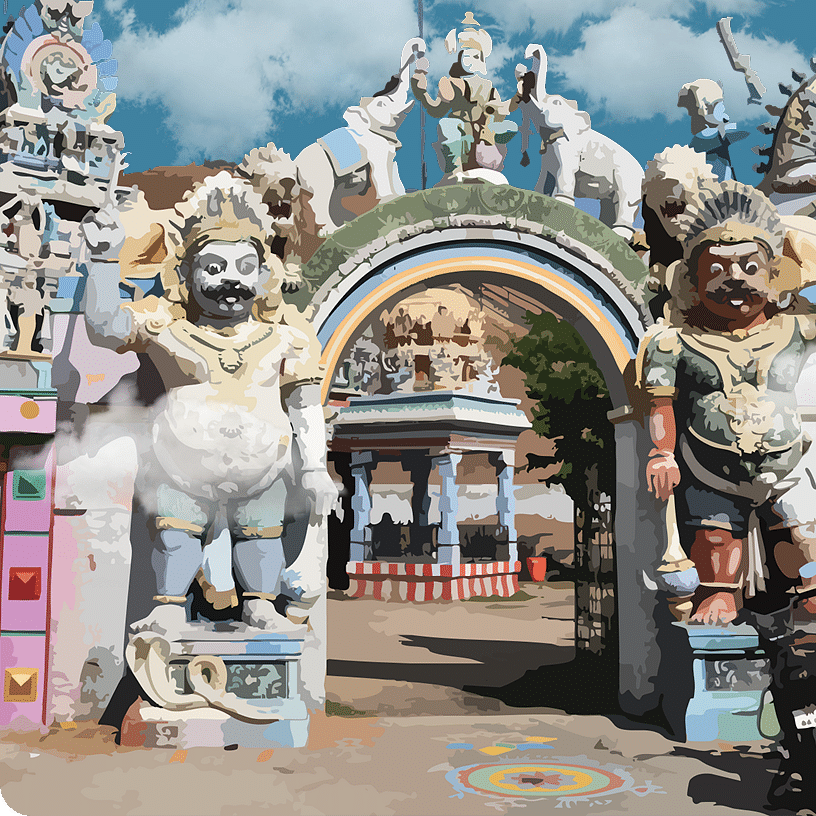
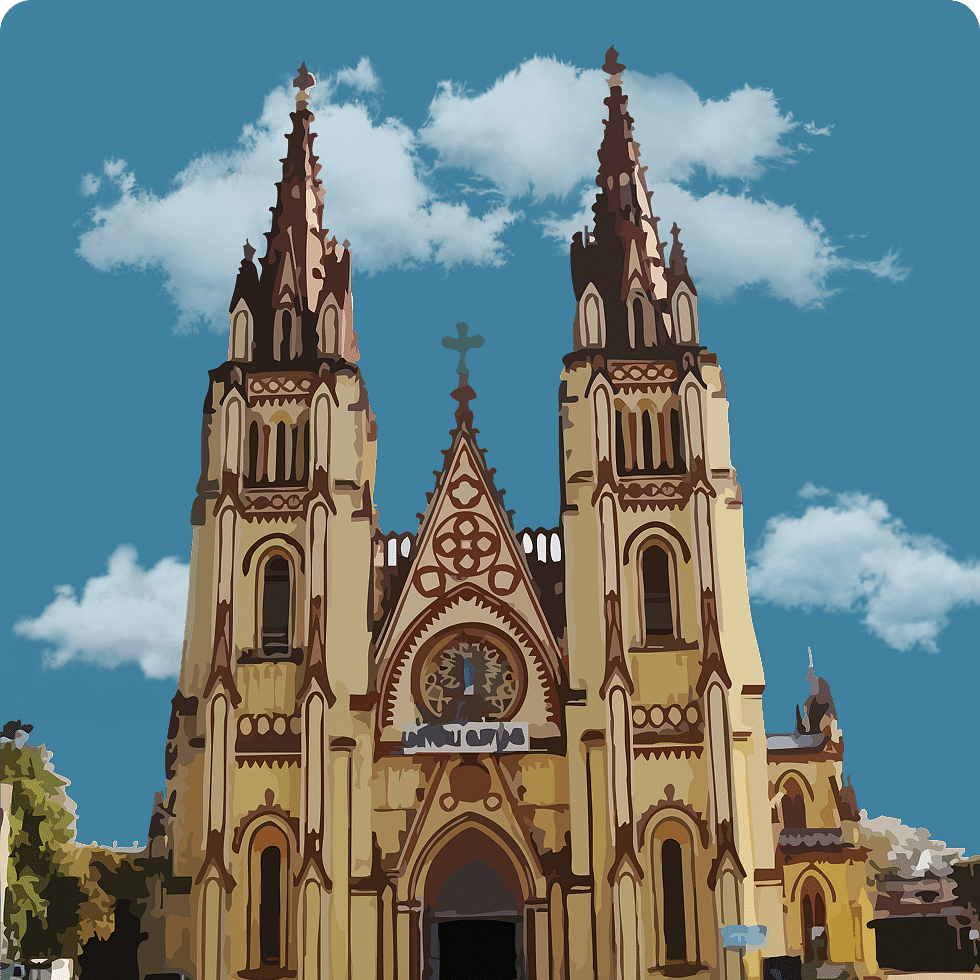
ST. MARY'S CATHEDRAL✨
Built from humble beginnings by Fr. Bertrend SJ in 1840, this chapel overcame war and hardship to become a majestic cathedral. Blending European and Roman styles, it now stands as a powerful symbol of faith, resilience, and architectural grace.
Distance from Regency Madurai5 km
Distance from Grand Madurai5 km
Timing7:00 a.m. to 7:00 p.m.
FestivalChristmas: (Dec)
Easter: (Apr)
Good Friday: (Apr)Sacred Food OfferedHoly bread (Sacramental bread), Wine (During eucharist)
Transportation CostFor assistance, please contact the front desk.
Disclaimer: The church's timings are subject to change as per the operating committee's decisions.
About St. Mary’s Cathedral:
- The foundation of the church dates back to 1840 when Fr. Bertrend SJ purchased a piece of land, and a mini chapel dedicated to Our Lady of Dolours was constructed in 1841 by Fr. Garnier.
- In 1855, during Fr. Trincal's tenure, the Catholic population in the area grew significantly, from 600 to 2500, necessitating the expansion of the church.
- The church's expansion was carried out by Fr. Hibolite SJ and Br. Lemothe SJ, who built two bell towers in Roman style around 1972.
- The church was further extended into its current Gothic style in three parts, although the completion was delayed due to the lack of funds from Europe during World War I.
- In 1914, Fr. Planchard had to sell the land (now the location of the Mission Hospital opposite the Cathedral) to continue the church's construction, which was finally completed in 1916.
- The church was blessed on 15th August 1916 by Msgr. Faisandier, marking its official completion.
- The Navaranga Mandapam, built by the Nayaks, and the Pandiya-influenced architecture add immense historical value to the temple. The church's design was overseen by Mr. Savarimuthu, the architect who also worked on the buildings of St. Joseph’s College.
- When Madurai was established as a new diocese, Msgr. Leonard SJ declared the church as the Pro-Cathedral, and later, under the leadership of Msgr. Justin Diraviam, it attained the status of a Cathedral in 1969.
- The church is renowned for its unique blend of European, Roman, and Continental architectural styles, contributing to its spiritual and aesthetic significance.
- The church continues to be a prominent attraction in Madurai, serving a parish with over 1600 Catholic families across 15 sub-stations.
- The church’s two bell towers stand at an impressive height of 42 metres, further highlighting its architectural grandeur.
- With a history spanning over 150 years, the church remains an important spiritual and cultural centre for traditional and settled Catholic communities in the region.
GORIPPALAYAM DARGAH✨
Built in the 16th century, this dargah blends Islamic, Hindu, and Tamil styles. With sacred tombs, a majestic dome from the Azhagar Hills, and the vibrant Urs festival, it stands as a symbol of healing, unity, and spiritual harmony.
Distance from Regency Madurai6 km
Distance from Grand Madurai10 km
Timing7:00 a.m. to 7:00 p.m.
FestivalAnnual Urus: (Feb-Mar)
Dargah Kanthuri Festival: (Jan)Transportation CostFor assistance, please contact the front desk.
Disclaimer: The temple's timings are subject to change as per the operating committee's decisions.
About Gorippalayam Dargah:
- The dargah is a 16th-century Sufi shrine located in Madurai, Tamil Nadu, dedicated to Hazrat Sultan Sikandar Badshah, a descendant of the Prophet Muhammad.
- It showcases a remarkable blend of Islamic, Hindu, and Tamil architectural influences, reflecting the syncretic culture of the region.
- The dargah is known for its beautiful tile work, ornate carvings, and majestic domes, which make it an architectural marvel.
- The tombs of Sultans of Yemen, Khaja Syed Sultan Alauddin Badusha Razi and Khaja Syed Sultan Shamsuddin of the Madurai Sultanate, are enshrined within.
- Another important tomb in the dargah is the invisible grave of Khaja Syed Sultan Habibuddin Razi, known as Ghaibi Sultan, who is said to have come to India to spread Islam.
- The dome of the dargah, which is 70 ft. in diameter and 20 ft. in height, is made from a single block of stone brought from the Azhaga Hills.
- It is believed that Thirumalai Nayak, the king of the Nayak dynasty, built the dargah for his Muslim subjects.
- The dargah hosts vibrant celebrations, including the annual Urs festival, which features processions, qawwalis, and whirling dervishes.
- The spiritual significance of the dargah, along with its believed healing powers, attracts devotees from all faiths.
- As a cultural, spiritual, and architectural landmark, it has become a must-visit destination for tourists seeking a unique experience in South India.
Divine Facts:
In the world of Sufism, it’s not all about silent meditation and peaceful reflection—sometimes, it’s about making a grand entrance, leaving a trail of divine inspiration, and maybe picking up a few villages along the way. Enter Hazrat Khaja Syed Sultan Alauddin Badusha Razi and Hazrat Khaja Syed Sultan Shamsuddin. These two Yemeni brothers didn’t just come to Madurai to sip chai and ponder life’s mysteries—they were here to stir things up a bit, spread some wisdom, and maybe grab a couple of villages while they were at it. Why settle for a humble plot when you can snatch six villages for the price of a foot of gold? Now that’s a real estate deal! While most people make their mark on history with a few inspiring words or maybe a new idea, these two went the extra mile—they locked down their village deal with none other than a royal legal document. Fast forward a bit, and—plot twist—a dispute breaks out over who actually owns these villages. The Huqdars of the dargah and the Nayak government weren’t exactly exchanging peace offerings. So, who do they call? The king! King Veerappa Nayakkar wasn’t handing out verdicts like free samples at the market—he ruled with an iron fist, and his ruling was clear: The Sultan’s family owns this land, and if anyone disagrees, it’s like slaying a cow by the Ganga. Talk about dropping the mic in the courtroom. But wait—there’s more! Not every legend comes with a grand tomb to admire. Enter Hazrat Khaja Syed Sultan Habibuddin Razi, also known as the Ghaibi Sultan, whose tomb is. Well, it’s invisible—he’s the original low-key saint. Who needs a grand mausoleum when you can leave everyone guessing if they’ve found your final resting place? Talk about ghosting with style! And just when you think the drama is over, enter the annual Urus festival. Forget your average religious celebration—this one’s the real deal. With whirling dervishes, lively processions, and enough spiritual energy to make even the most sceptical person think. They didn’t just stop at prayers and offerings—they threw in some drama, excitement, and a hefty dose of divine humour. So, while the rest of Madurai carries on with their usual hustle, there stands this dargah, humming with the legacy of two Yemeni brothers who came to spread Islam, snag a few villages, and leave a spiritual imprint that still resonates today. And let’s be real—who wouldn’t want to leave a legacy that includes a royal land dispute, an invisible tomb, and an annual celebration that draws everyone from mystics to tourists? Now that’s what you call a divine success story!
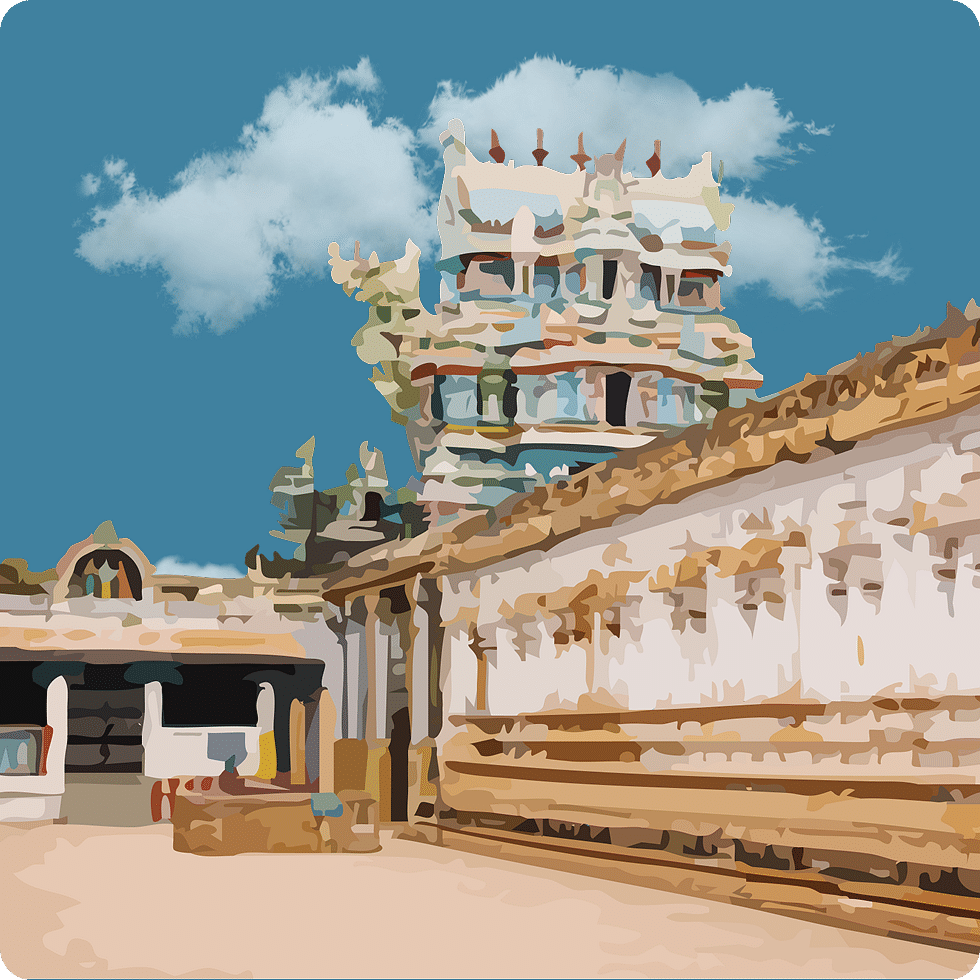
THIRUMOGOOR SHRI KALAMEGHAPERUMAL TEMPLE✨
Over 2,000 years old, this temple features a five-tiered rajagopuram and a rare 16-handed deity. Blending ancient architecture with divine symbolism, it has endured through time as a beacon of faith, attracting pilgrims with its deep spiritual and historical significance.
Distance from Regency Madurai19 km
Distance from Grand Madurai13 km
Timing6:00 a.m. to 12:00 p.m.
4:00 p.m to 8:00 p.m.FestivalVaikasi Brammotsavam: (May-Jun)
Tamil New Year: (Apr)
Navarathri: (Sep-Oct)
Margazhi: (Dec-Jan)
Vaikunta Ekadashi: (Dec)
Gajendra Moksham: (Apr-May)
Krishna Jayanthi: (Aug)Sacred Food OfferedKesari, Pongal, Tamarind rice
Transportation CostFor assistance, please contact the front desk.
Disclaimer: The temple's timings are subject to change as per the operating committee's decisions.
About Thirumogoor Shri Kalameghaperumal Temple:
- The temple is over 2,000 years old and has been an important site for worship throughout history.
- It is located on a 2.5-acre land and features a five-tiered rajagopuram.
- The main deity (Moolavar) is Kalamegapperumal, who is enshrined in a unique standing posture and depicted with 16 hands and three eyes.
- The temple is famous for its Sudarshana Chakra, a key feature in the temple’s design.
- The deity's distinctive posture, known as Prathanasayana, is not found anywhere else among the 108 Divya Desam temples.
- The front of the Sudarshana Chakra is adorned with Chakrathazhvar, and the back side features Narasimha Perumal.
- The temple’s premises are surrounded by six circles, each containing 16 Aayuthams (divine weapons) and 154 letters.
- The temple is significant for its association with several key figures in Tamil literature, including Thiruvalluvar’s epics.
- Nammalvar and Thirumangai Azhvar have sung praises and hymns dedicated to the deity here.
- The temple's Moolavar deity is adorned with a unique depiction of 48 gods in various forms, engraved around the temple.
- Lord Vishnu is represented here holding various weapons in each of his 16 hands, a feature unique to this temple.
- It is an important pilgrimage site for followers of Vaishnavism, particularly those following the tradition of Sri Vaishnavism.
- Lord Kondanna, Lord Sita, Lakshmi, Kamadeva, and Rathidevi are depicted in the Garuda Mandapam in the temple.
- The temple’s iconic Utsavar, known as Thirumogam, is performed with special Pancha Aayudhams and attracts numerous devotees throughout the year.
Divine Facts:
Somewhere in the great cosmic theatre, where devas scheme and asuras dream big (often too big), there lived a demon with ambition—and a flair for the dramatic. Bhasmasura wasn’t an average power-hungry villain. He did what most asuras rarely attempted: intense tapas. His target of devotion? None other than Lord Shiva, the ultimate ascetic with a soft spot for sincere seekers. Moved by Bhasmasura’s fiery penance, Shiva granted him a rather explosive boon—the power to reduce anyone to ashes with a single tap on their head. Instant cremation. Bhasmasura was thrilled. Finally, a shortcut to the top of the asura leaderboard. But here’s the twist: in a move that would baffle even the wisest celestial therapist, Bhasmasura immediately decided to test his new power on Lord Shiva himself. As Shiva gracefully exited stage left (at divine speed), it was time for some cosmic damage control. Enter Lord Vishnu—the multitasker of the trinity, who handles everything from avatar appearances to cleaning up celestial messes. Realising that brute force wouldn’t do, Vishnu reached into his divine bag of tricks and pulled out Mohini. Mohini wasn’t just beautiful—she was beauty, grace, and mischief wrapped into one dazzling form. She appeared before Bhasmasura with the elegance of a dancer and the timing of a master strategist. Mohini twirled, swayed, and spun, and Bhasmasura followed, mesmerised, mimicking her every move. It was a dance-off with consequences. Step by step, hand gesture by hand gesture, he shadowed her—until she gently tapped her head. Bhasmasura, completely under the spell, did the same. One second, he was lost in admiration. The next? Ashes to ashes, quite literally. Thus, at Thirumohur, the curtains fell on one of the strangest dance tragedies in mythological memory.PILLAYARPATTI KARPAGA VINAYAGAR TEMPLE✨
Dating back to the 7th century, this rock-cut shrine features a rare two-handed Vinayaga, panchaloga statues, and shrines for three Lingams and goddesses, offering a revered space for divine grace, marital blessings, and spiritual faith.
Distance from Regency Madurai83 km
Distance from Grand Madurai75 km
Timing6:00 a.m. to 1:00 p.m.
4:30 p.m. to 8:30 p.m.FestivalVinayagar Chathurthi: (Sep)
Pongal: (Jan)
Tamil New Year: (Apr)
ThiruKarthigai: (Nov-Dec)
Deepavali: (Oct-Nov)
Navarathri: (Sep-Oct)
Avani Utsavam: (Jul)Sacred Food OfferedKozhukattai
Transportation CostFor assistance, please contact the front desk.
Disclaimer: The temple's timings are subject to change as per the operating committee's decisions.
About Pillayarpatti Karpaga Vinayagar Temple:
- The deity worshipped at this temple is Lord Vinayaga, also known as ‘Karpaga Vinayagar’, who is believed to grant the wishes of devotees, much like the Karpagam tree.
- Lord Vinayaga in this temple is depicted with two hands, unlike other representations where he is shown with four hands.
- He is seated in the ‘Artha Padma’ Asanam, with his legs folded and his stomach not touching the seat, a unique posture seen in this temple.
- Devotees who worship facing north are believed to be blessed with wealth and prosperity.
- The temple is dedicated to ‘Marudeeswarar’, with worship of the Marudha tree (Arjuna tree) as an integral part of its rituals, signifying its ancient heritage.
- A notable sculpture of Pasupatheeswarar is featured, depicting a cow offering milk to Lord Shiva, a unique and special feature of this temple.
- Kubera, the Lord of Wealth, is believed to have worshipped here, adding to the temple’s spiritual significance.
- Goddess Laxmi, Saraswathi, and Durga are enshrined together at this temple, symbolising a complete spiritual harmony.
- The temple houses three Lingams—Thiruveesar, Marudheesar, and Senchadeswarar—along with three goddesses—Sivagami Amman, Vadamalar Mangai Amman, and Soundara Nayaga Amman—blessing devotees in a single location.
- Worship of Kathyayini Amman at this temple is believed to relieve women from ‘Sevvai Dosham’, which is said to hinder marriage.
- A separate sannidhi, known as the Sakthi Sannidhi, is dedicated to ‘Sabda Madhar’, an important deity due to changing times.
- Over 15 inscriptions within the temple help establish its antiquity and history.
- The temple has a rock-cut cave shrine dating back to the 7th century AD, which was expanded over time, with restoration work done in the late 19th century.
- During restoration, panchaloga statues from the 11th century AD were discovered, further adding to the temple’s rich historical legacy.
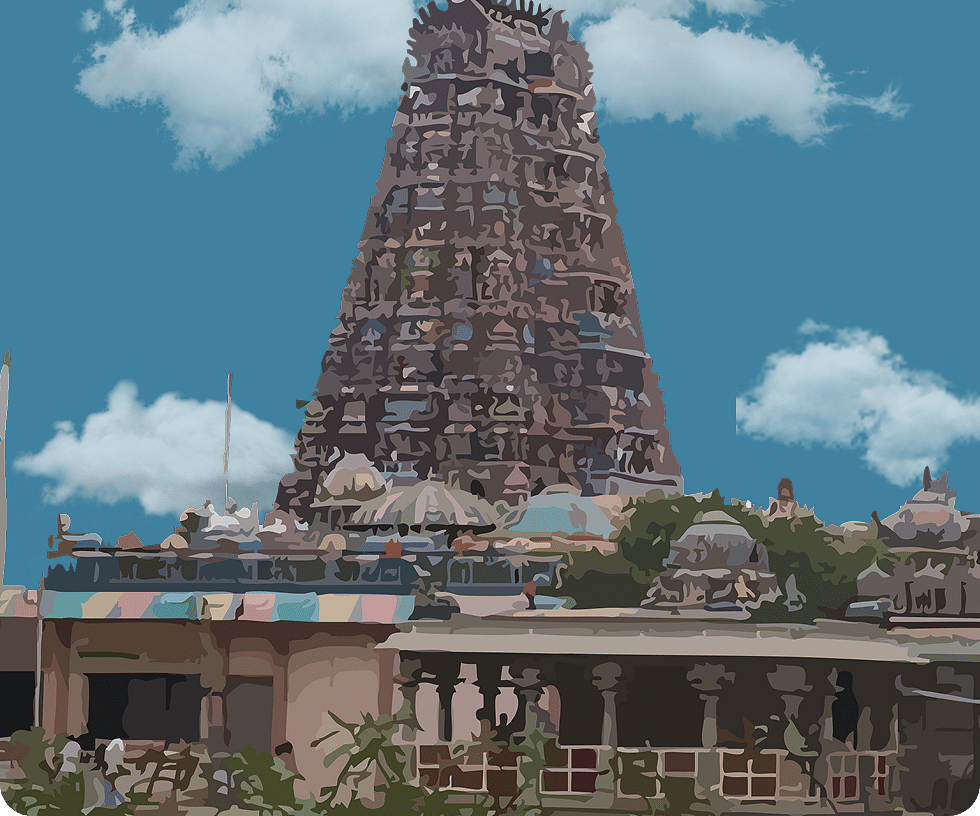
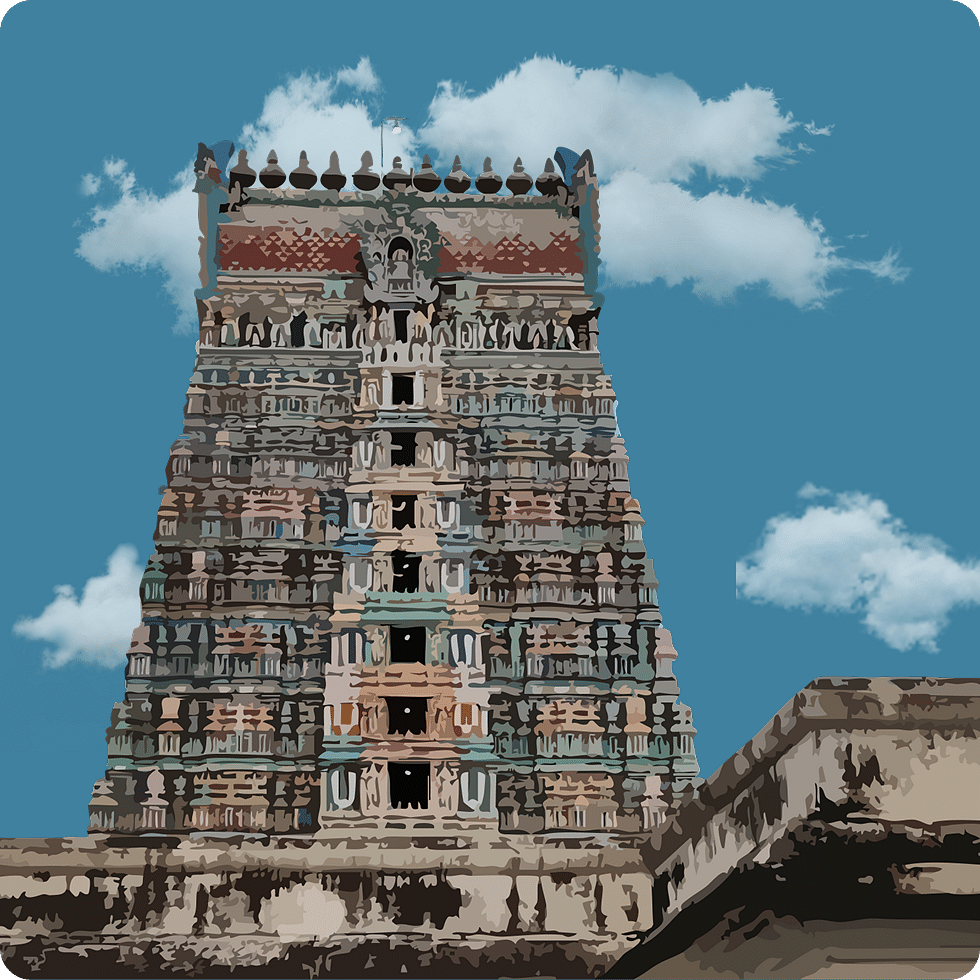
SRIVILLIPUTTUR ARULMIGU ANDAL SAMETHA RANGAMANNAR TEMPLE✨
Dedicated to Lord Vishnu as Vadabadrasayi and Andal, this 108 Divya Desam temple boasts a 194-foot Rajagopuram and intricate carvings. A cultural hub, it celebrates Carnatic music, dance, and divine grace, steeped in rich history.
Distance from Regency Madurai75 km
Distance from Grand Madurai81 km
Timing6:30 a.m. to 1:00 p.m.
4:00 p.m to 9:00 p.m.FestivalAani Alvar Uthsavam: (Jul-Aug)
Thiruvadipooram: (Aug)
Purattasi Utsavam: (Sep-Oct)
Ennaikappu: (Dec-Jan)
Panguni Thirukkalyana Utsavam: (Apr)
Chitritsavam: (Apr-May)
Aadi Pooram: (Jul-Aug)
Vasantha Utsavam: (Feb-Mar)
Peria Perumal Bramhotsavam: (Dec-Jan)
Theppostavam: (Mar)
Andal Mannar Thirukalyanam: (Mar-Apr)
Car festival: (Aug)Sacred Food OfferedHoly water
Transportation CostFor assistance, please contact the front desk.
Disclaimer: The temple's timings are subject to change as per the operating committee's decisions.
About Srivilliputtur Arulmigu Andal Sametha Rangamannar Temple:
- Revered as the only temple where the presiding deity is a woman saint, Andal is worshipped as an incarnation of Goddess Bhudevi, her verses from the Thiruppavai still recited daily during the sacred Margazhi season.
- The 192-foot Rajagopuram, a magnificent example of Dravidian architecture, is believed to have inspired the emblem of the Tamil Nadu Government, symbolising its cultural and historical prominence.
- The triple-door sanctum offers a layered darshan of Lord Vatapatrasayi, allowing devotees to view the deity in a unique and immersive manner.
- A showcase of Vijayanagara-era craftsmanship, the complex features intricately carved pillars, life-sized deities, and rare composite columns depicting fierce forms like Virabhadra.
- The Kalyana Mandapa, a hall commemorating Andal’s divine marriage, is adorned with majestic sculptures, blending celestial themes with artistic elegance.
- The grand Aadi Pooram festival celebrates Andal’s spiritual union with Lord Ranganatha, drawing thousands of devotees in a colourful display of music, flowers, and devotion.
- Legends abound—from sages meditating in the ancient Shenbagaranya forest to the story of Queen Malli’s sons, Villi and Kandan, whose fates gave rise to the town’s name.
- The once colossal temple car, once measuring up to 40 metres, stands as a testament to historic engineering brilliance, with efforts underway to revive its ceremonial use.
- Teak carvings, vibrant murals, and sacred gardens—where Andal is believed to have been discovered—create a serene atmosphere for spiritual reflection.
Divine Facts:
Many moons and stars ago (because regular calendars weren’t dramatic enough), under the gentle shade of a Tulsi plant, arrived a miracle, no chariots, no thunderclaps, just a baby girl with divinity in her breath and poetry in her soul. Found by a simple cowherd, who must’ve wondered if the gods had mixed up their delivery address, she would grow up to become none other than Andal—Tamil Nadu’s very own saint-poet, spiritual icon, and pioneer of devotional verses with dramatic flair. While other kids were busy scribbling on walls, Andal was composing hymns that made even the celestials pause mid-flight. Her love for Lord Vishnu wasn’t a quiet, bashful kind—it was bold, brilliant, and ballad-worthy. With words that could move mountains (and deities), she wove her longing into verse, each line an offering more powerful than a thousand lamps. And Lord Vishnu? He didn’t just listen. He showed up. That’s right—no trumpet, no fancy flash. Just the divine groom arriving for his poet-bride, turning Andal’s dream into sacred reality. And in the heart of Srivilliputhur, a temple rose, towering, intricate, and so grand it could’ve inspired entire architectural movements. Its 194-foot gopuram reaches for the skies like it’s in mid-praise itself, carved with a precision that makes modern tools look like toys. But this isn’t a solo story. Enter Periyalvar—Andal’s foster father, fellow poet, and Vishnu’s top devotee on speed dial. Together, they created a devotional legacy that made Srivilliputhur a Vaishnavite nucleus, pulling pilgrims in like bhakti-grade gravity. Through the ages, everyone from Cholas to Vijayanagara Nayaks took turns playing temple decorator. Inscriptions line the stone walls—some so detailed, even a scroll-happy historian might need a tea break halfway through. And the final flourish? The majestic Rajagopuram, courtesy of Barathi Rayar. Step inside, and you’ll find Sri Rangamannar—Lord Vishnu in his most radiant form—sharing the sanctum with Andal. The murals? Mythological masterpieces. The vibe? Sacred with a side of artistic grandeur. But this temple isn’t all hush and incense. When the festivals roll in, it transforms into a cultural carnival—Carnatic concerts, classical dance, the whole divine shebang. If there had been a cosmic playlist, Andal’s verses would be the headliner. So if you're in the mood for timeless devotion, awe-inspiring architecture, and a love story written in divine metre, Srivilliputhur is calling. Bring your prayers, your curiosity, and maybe keep an ear out—you might just catch a celestial song in the breeze.ARULMIGU KOODAL AZHAGAR TEMPLE✨
Vishnuchitha, a revered Alwar, defended Lord Vishnu’s supremacy before the Pandya King, witnessing a divine miracle. Grateful, he composed Thirupallandu, a hymn still chanted in the temple, preserving this sacred encounter for generations.
Distance from Regency Madurai3 km
Distance from Grand Madurai7 km
Timing6:30 a.m. to 12:00 p.m.
4:00 p.m. to 8:00 p.m.FestivalVaikasi festival: (Jun)
Brahmotsavam: (May-Jun)
Float festival: (May)
Garuda Seva: (May)
Celestial Wedding Festival: (May)
Adyayana utsava: (Dec)
Navarathri festival: (Sep-Oct)
Vasantha Utsava: (Dec-Jan)
Krishna Janmashtami: (Aug)
Vaikuntha Ekadasi: (Dec)Sacred Food OfferedPuliyodharai, Chakkarai pongal, Ven pongal
Transportation CostFor assistance, please contact the front desk.
Disclaimer: The temple's timings are subject to change as per the operating committee's decisions.
AboutArulmigu Koodal Azhagar Temple:
- The temple is one of the 108 Divya Desams, a sacred abode of Lord Vishnu, and holds significant importance for devotees of the Vaishnavite tradition.
- The five-tiered Rajagopuram is a notable architectural feature of the temple, drawing visitors with its grandeur and intricacy.
- Located in the heart of Madurai, the temple is near the famous Meenakshi Amman Temple, making it an essential stop for pilgrims and tourists alike.
- The main shrine houses the idol of Lord Koodal Azhagar, while the southern side has a shrine dedicated to Goddess Madhuravalli, the consort of the deity.
- Small shrines dedicated to other deities, such as Lord Krishna, Lord Rama, Goddess Lakshmi, and Lord Narayana, can also be found within the temple complex.
- The temple’s origins trace back to the Pandya reign, with later developments and architectural additions during the Vijayanagar dynasty and Madurai Nayak rule.
- Inscriptions inside the temple document numerous donations and gifts received during various reigns, highlighting the temple's importance across centuries.
- Renovations of the temple were carried out in the 1920s, and it is currently maintained by the Hindu Religious and Endowment Board of the Tamil Nadu government.
- During the Pandyan regime, the Avani Onam festival dedicated to Lord Koodal Azhagar was celebrated for seven days with great reverence.
- The temple holds significance in the Brahmanda Purana, with mention of Lord Koodal Azhagar’s divine blessings and his association with the legendary King Prithu and Malaydioaja.
- The temple remains a place of historical and spiritual importance, reflecting the cultural richness of Madurai and its enduring connection to Tamil literary and religious traditions.
Divine Facts:
Once upon a divine debate, in the days when devotion doubled as scholarship, there lived a brilliant Alwar named Vishnuchitha. But don’t picture a quiet, meditative sage lost in chants—this was a man on a mission, presenting Lord Vishnu’s greatness like a spiritual statesman. Armed with scriptures, shlokas, and sheer conviction, he wasn’t just praying—he was proving a point. Word of his wisdom travelled all the way to the Pandya king’s court in Madurai. So, Vishnuchitha was summoned—not to perform, but to persuade. And what a show it was. With the calm of a yogi and the logic of a philosopher, he spoke of Lord Vishnu’s supremacy with such grace that even the seasoned scholars in the room paused, mid-scroll. Impressed beyond measure, the king ordered a grand procession—think Vedic victory parade. But the real climax was yet to come. Amidst the celebration, Lord Vishnu himself made a divine appearance. No trumpets needed—his presence was a miracle enough. He blessed Vishnuchitha, who, overcome with devotion, burst into verse—singing the first-ever Thirupallandu, a heartfelt Mangalasasanam straight from soul to sky. And that chant? It still echoes through the temple halls today, not just as a hymn, but as a memory of a scholar, a sovereign, and a god, all united in one unforgettable moment of faith and revelation.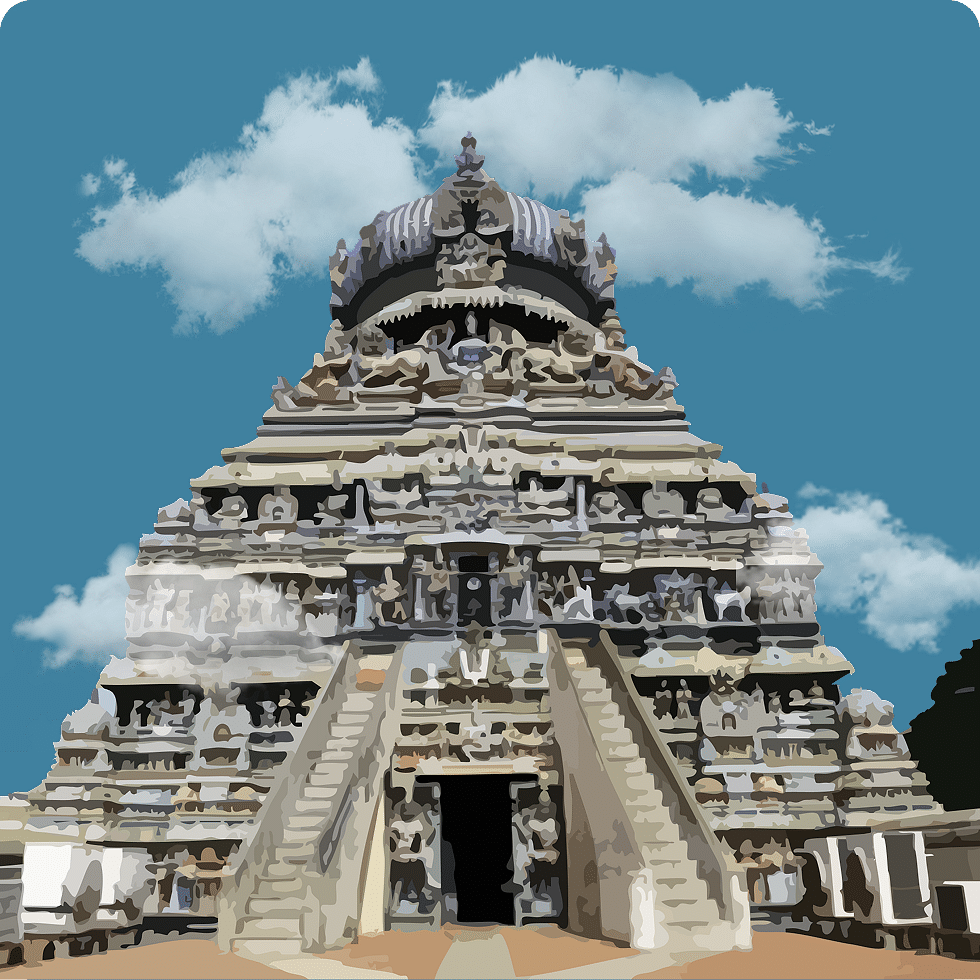

NARASINGAM YOGA NARASIMHA PERUMAL TEMPLE✨
Carved in 770 AD, this hill-temple enshrines Yoga Narasimha, sculpted from rock. Rooted in legends, it blends myth, history, and devotion. Celebrated for its standing idol, inscriptions, and Pradosha rituals, it remains a spiritual destination.
Distance from Regency Madurai4 km
Distance from Grand Madurai15 km
Timing7:00 a.m. to 12:00 p.m.
4:00 p.m to 8:00 p.m.FestivalChithirai Festival: (Apr-May)
Navarathri: (Sep-Aug)
Vaikunta Ekadesi: (Dec)
Pongal: (Jan)Sacred Food OfferedPongal, Sundal
Transportation CostFor assistance, please contact the front desk.
Disclaimer: The temple's timings are subject to change as per the operating committee's decisions.
About Narasingam Yoga Narasimha Perumal Temple:
- Carved out of a single rock in 770 AD during the Pandya reign, the temple stands as a remarkable feat of ancient architecture and sculptural excellence.
- The main sanctum houses Yoga Narasimha, whose image was sculpted directly from the hill itself—a unique example of rock-cut devotion.
- The temple is located between two sacred sites—Alagar Koil to the north and Thirumohur to the east—creating a spiritually powerful triangle.
- Legends mention that Sage Romasa performed intense penance here, leading to Lord Narasimha manifesting in his fierce Ugra form, later pacified into Yoga Narasimha with the help of Prahlad and Goddess Lakshmi.
- The site is also tied to the tale of Shiva’s Brahmahatya Dosham. After severing one of Brahma’s heads, Shiva bathed in the temple’s sacred tank and prayed here to be absolved of the sin.
- In a mythical war between the Cholas and Pandyas, a Jain-created magical elephant was turned into a hill by Shiva’s Narasinga Astra to protect the Pandya dynasty, giving rise to the temple’s very foundation.
- The Utsava Murti (processional deity) in a rare standing posture features Sudarshana Chakra, Panchajanya (conch), a Gada (mace), and Abhaya Hasta—this form is unique and found nowhere else.
- Inscriptions in Tamil, Vattezhuthu, and Brahmi chronicle generous land and monetary gifts made across centuries to support temple festivities and maintenance.
- Devotees circumambulate the hill on Full Moon days, particularly during Maasi Pournami, when the Gajendra Moksham episode is ceremoniously enacted.
- It is widely believed that sincere participation in the Narasimha Pradosha Pooja can remove marriage obstacles and shield one from adversities.
Divine Facts:
Many yugas ago, when sages meditated for longer than we’d think possible, Sage Romasa had a rather bold request. He wasn’t after a simple darshan from Lord Vishnu—he wanted the full Narasimha experience. Not the gentle, peaceful version, but the fierce lion-man form that would shake the heavens. So, where did he choose to meditate for this? By the tranquil Padma Thadakam, a serene lotus-filled pond—a place of calm to summon the storm. Romasa’s persistence paid off, and Lord Narasimha appeared in all his fiery glory, in his Ugra roopa—so intense that even the gods started to feel the heat. And let’s be honest, for gods to break a sweat, something big is going down. The celestial beings tried everything in their divine toolkit to calm the situation, but to no avail. Enter Prahlad, the original Vishnu devotee, who stepped in to soothe the wrath with a peaceful prayer. With Mahalakshmi’s gentle touch, Narasimha’s fury was tempered, transforming into the serene Yoga Narasimha. The heavens could finally breathe easy. But the divine drama didn’t stop there. Lord Shiva, having chopped off one of Brahma’s heads, was left carrying the guilt of his actions like an unfinished errand. Seeking redemption, he took a dip in Chakra Theertham and prayed to Narasimha. With that, his dosham was cleared, and Shiva emerged cleansed, ready for divine business once more. Now, for a plot twist fit for the stars. A Chola king, desperate to outwit his Pandya rival, teamed up with a group of Jains and, believe it or not, conjured a giant magical elephant. Because who doesn’t need a mystical elephant for backup? But the Pandya king had his own divine connections. With prayers to Shiva, the Narasinga Astra was sent down. And that enchanted elephant? It turned into a hill. Talk about divine justice served on a cosmic platter. And so, from fiery avatars to remorseful gods, from sages with dreams to elephants that defy logic, this legendary hill temple came to life, where stone, story, and devotion intertwine, echoing through the ages.RAMANATHASWAMY TEMPLE✨
Located in Rameshwaram, this Jyotirlinga shrine blends celestial lore with architectural splendour. With two sacred Lingas, endless corridors, towering gopurams, and 22 Theerthams, it remains a sanctuary for penance, pilgrimage, and spiritual grace.
Distance from Regency Madurai178 km
Distance from Grand Madurai170 km
Timing5:00 a.m. to 1:00 p.m.
3:00 p.m. to 9:00 p.m.FestivalAadi Amavasai: (Aug)
Mahalaya Amavasai: (Oct)Sacred Food OfferedPuliyodharai (Tamarind rice), Vibhuti (Holy ash), and Sacred kumkum
Transportation CostFor assistance, please contact the front desk.
Disclaimer: The temple's timings are subject to change as per the operating committee's decisions.
About Ramanathaswamy Temple:
- This sacred site is one of the twelve Jyotirlinga temples in India, making it a significant pilgrimage destination for Shaivites.
- The temple is famed for its awe-inspiring corridors, stretching over 1,200 metres—some of the longest of any Hindu temple.
- The main deity, Ramalingam, is believed to have been crafted by Goddess Sita from sand, while Vishwalingam, brought by Hanuman, is also enshrined.
- Devotees can purify themselves in 22 Theerthams (holy water bodies) within the temple premises, each with its own legend and spiritual significance.
- A massive 17.5-foot idol of Nandi, Shiva’s sacred bull, stands guard, watchful, wise, and quite photo-worthy.
- With exquisite sculptural artistry and majestic gopurams, the temple isn’t just spiritually enriching—it’s an architectural wonder etched in stone.
Divine Facts:
Before the stars found their rhythm and the galaxies began their cosmic waltz, a different kind of tale was unfolding here on Earth—one that was timeless, tender, and divinely crafted. Fresh from his victory over Ravana in Lanka, Lord Rama decided it was time for a little spiritual balance. Think of it as a cosmic ‘do-good’ gesture—after all, even gods need to show a little devotion every now and then. So, he sent Hanuman on a quest to fetch a Shiva Linga from the holy land of Kashi. Now, Hanuman’s fast, no question about it, but even celestial couriers hit traffic. The moment the auspicious time drew near, Sita, ever the picture of calm, took matters into her own hands (quite literally). She sculpted a Linga from the sands, proving once and for all that true devotion doesn’t need a grand delivery. When Hanuman finally arrived, eager to present his precious cargo, he was a bit taken aback to find that Sita had already nailed the job. But wait—don’t worry! His Linga wasn’t a total waste. It was enshrined as the Vishwalingam, a divine companion to the Ramalingam created by Sita. Two Lingas. One timeless tale. And an everlasting reminder that when devotion calls, sometimes you don’t need a fast lane to reach the divine.